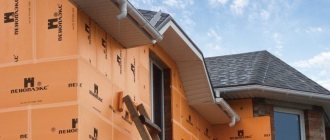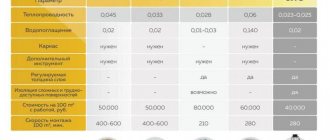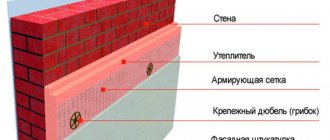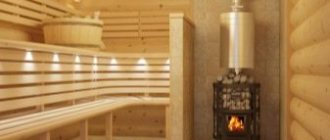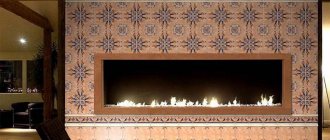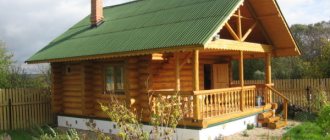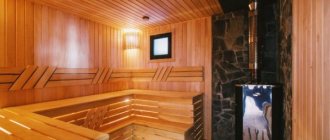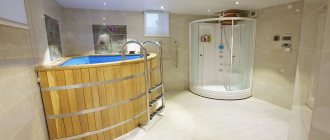Penoplex is a building heat-insulating material in the form of slabs of extruded polystyrene foam, in demand due to its lightness, strength and durability. In structure, it is similar to the usual polystyrene foam, but is more dense.
The barely visible pores of the insulation, measuring from 0.1 to 1 mm, are the result of new manufacturing technologies. In appearance, the slabs consist of a homogeneous material, which is actually finely porous with insulated cells, providing low thermal conductivity and water resistance.
A variety of grades and enhanced strength allow it to be used for insulating floors, roofs, and foundations.
Types, technical characteristics and purpose
Since 2011, product differentiation has been introduced depending on the purpose and area of application. This allows you to quickly find out the type of insulation you need with a set of characteristics for a specific type of work and promotes maximum efficient use.
Several types of extruded polystyrene are available:
WALL, or penoplex 31 with fire retardants
Designed for insulation of surfaces without dynamic or static load. Optimal for insulating facade walls, partitions, swimming pools, wells, heating networks, water supply systems.
Characteristics:
| Properties | Unit | Index |
| Thermal conductivity, 25°С | W/(mK) | 0,03 |
| Density | kg/m3 | 25,0–32,0 |
| Strength | MPa (kgf/cm2; t/m2) | 0,20(2,0; 20) |
| Water permeability, 28 days | % by volume | 0,5 |
| Fire protection | group | G3 |
| Working temperature | С° | from -50 to +75 |
FOUNDATION, or penoplex 35 without fire retardant
The slabs are designed for heavy loads and are durable. Ideal for road surfaces, foundations, floors, and basement equipment. The presence of a waterproofing barrier allows groundwater to be drained from the underground part of the house.
Characteristics:
| Properties | Unit | Index |
| Thermal conductivity, 25°С | W/(mK) | 0,03 |
| Density | kg/m3 | 29,0–33,0 |
| Strength | MPa (kgf/cm2; t/m2) | 0,27 (2,7; 27) |
| Water permeability, 28 days | % by volume | 0,5 |
| Fire protection | group | G4 |
| Working temperature | С° | from -50 to +75 |
ROOFING, or penoplex 35
The slabs are designed for insulation of roofs and attic spaces of any type, taking into account climatic precipitation and temperature changes. Currently, it is used for flat roofs with winter gardens or parking lots placed on it (inversion roofing).
Characteristics:
| Properties | Unit | Index |
| Thermal conductivity, 25°С | W/(mK) | 0,03 |
| Density | kg/m3 | 28,0–33,0 |
| Strength | MPa (kgf/cm2; t/m2) | 0,25 (2,5; 25) |
| Water permeability, 28 days | % by volume | 0,5 |
| Fire protection | group | G3 |
| Working temperature | С° | from -50 to +75 |
COMFORT, or penoplex 31C
Universal slabs are suitable for insulating loggias, balconies, walls and floors of saunas, and mansions. It is characterized by increased moisture resistance and provides an optimal microclimate. Due to technical features, slabs of this type are particularly tightly adjacent to each other.
Characteristics:
| Properties | Unit | Index |
| Thermal conductivity, 25°С | W/(mK) | 0,03 |
| Density | kg/m3 | 25,0–35,0 |
| Strength | MPa (kgf/cm2; t/m2) | 0,20 (2,0; 20) |
| Water permeability, 28 days | % by volume | 0,5 |
| Fire protection | group | G4 |
| Working temperature | С° | from -50 to +75 |
Penoplex 45
It is used for thermal protection of take-off surfaces and roads, protects against subsidence, deformation, and swelling of the canvas. Designed for heavy loads: can withstand the weight of an aircraft in regions with low temperatures. The strongest material retains its properties for a long time.
Characteristics:
| Properties | Unit | Index |
| Thermal conductivity, 25°С | W/(mK) | 0,03 |
| Density | kg/m3 | 35,0–47,0 |
| Strength | MPa (kgf/cm2; t/m2) | 0,50 (5,0; 50) |
| Water permeability, 28 days | % by volume | 0,4 |
| Fire protection | group | G4 |
| Working temperature | С° | from -50 to +75 |
Types of insulation boards
We insulate the floor on the balcony
Since there are plenty of varieties of penoplex on the construction market, manufacturers produce it with specific names that allow you to speed up the selection process. Let's look at these types:
- Penoplex “roofing” - the density of roof insulation slabs is 28-33 kg/m3. Lightweight and waterproof
- “Wall” - can be used for both interior and exterior work. The density of the material is 25-33kg/m3
- “Foundation” - high density and water resistance allows the material to be used during the construction of a foundation or basement. Density – 29-33kg/m3
- “Comfort” - slabs are used for balconies and apartments, as well as uninsulated loggias. Density – 25-35kg/m3
- Penoplex “45” - this material has the highest density among others, which is 35-47 kg/m2. This is why it is used during the construction of roads and runways.
Related article: Do-it-yourself parquet repair: step-by-step instructions
For the average consumer, I have compiled a table of the estimated cost of penoplex. Thanks to it, you can make approximate calculations of the required amount to purchase material of different thicknesses:
| Name | Thickness | Area/volume per package. m2/m3 | Sheets per package (quantity) | Cost of 1 package | Price for 1 sheet |
| PENOPLEX | 20 | 14,4/0,288 | 20 | 1 200 — 1 400 | 60-70 |
| 30 | 10,08/0,30 | 14 | 1 260 — 1 540 | 90-110 | |
| 40 | 7,2/0,288 | 10 | 1 200 — 1 400 | 120-140 | |
| 50 | 5,76/0,288 | 8 | 1 200 — 1 520 | 150-190 | |
| 60 | 5,04/0,30 | 7 | 1 260 – 1 274 | 180-182 | |
| 80 | 3,6/0,288 | 5 | 1 195 – 1 205 | 239-241 | |
| 100 | 2,88/0,288 | 4 | 1 200 – 1 240 | 300-310 |
Dimensions, thickness and cost
The stability of thermal insulation properties allows the use of slabs of medium thickness from 35 to 50 mm. This is average for a standard solution in a temperate climate.
Increased thickness of penoplex up to 70 mm or more is used in northern regions, where temperatures often drop to -300 C. This approach is justified, especially since the usual thickness of other insulation materials reaches 150 mm.
The dimensions of the slabs are standardized by the manufacturer to standard 1200 mm in length and 600 mm in width.
Compared to other types of insulation, the cost of penoplex is quite high: the price of 1 square meter of sheet is on average $5. If the material is modified with improved qualities, including fire retardant additives, then the price will be $7-8 per 1 sq.m.
Penoplex selection criteria
In order for the insulation to serve for a long time and not lose its properties, it is necessary to choose from a huge variety of products and manufacturers of high-quality penoplex.
It is also important to choose the material specifically for your needs. Our recommendations will help you do this:
- Consider the brand and series of heat insulator when choosing it for your purposes. In addition, pay attention to the size of the penoplex. Large slabs will be inconvenient to work in small spaces. You should also not buy material with a density below 25. It will not provide decent thermal insulation.
- Please note that penoplex with a density below 25 kilograms per cubic meter should raise doubts. High-quality material produced using the extrusion method cannot be too loose. Otherwise, you have foam plastic in front of you.
- Study the technical characteristics of penoplex indicated on the packaging. If you do not trust the manufacturer, you can independently weigh the material to determine its density and compliance with the declared one.
- Break off a piece of material from the edge. Extruded penoplex will produce a fracture with an abundance of regular polyhedra, but not round balls. The fault line must also pass through the cells.
Production technology and scope
The specifics of penoplex manufacturing are aimed at improving the strength and technical characteristics of the material.
It is given special properties by the process of extrusion from raw materials in special furnaces. First, polystyrene granules are mixed with a foaming agent under conditions of high humidity and temperature. The catalyst is a composition of carbon dioxide (CO2) and freon. The polystyrene foam composition is melted in ovens and resembles lush cream.
Then, through the extrusion installation, the substance begins to be squeezed out, the freon gradually evaporates, and the cells are filled with simple air.
The use of penoplex in the construction industry has practically no restrictions and, thanks to its technical characteristics, can significantly reduce the costs of other consumables and energy resources.
Currently, heat insulation is in demand in different climatic conditions for insulation and protection:
- foundations and walls of low-rise buildings;
- balconies and loggias;
- pools and wells;
- ceilings and basements;
- floors and ceilings;
- water supply systems;
- airfield runways;
- railways and roads;
Penoplex of various categories is widely used in the process of reconstruction of buildings due to its high resistance to environmental changes and chemical influences. The material is used to make sandwich panels.
Advantages of penoplex
The benefits of penoplex are very diverse. They concern exclusively high quality slabs from trusted manufacturers. The main advantages of insulation include:
- Excellent thermal conductivity
. Penoplex slabs can be used even in harsh winter conditions. They will reliably protect your home from the penetration of cold. In addition, repeated cycles of freezing and thawing do not harm the material in any way. - Light weight
. The material is very light, which greatly simplifies transportation, storage and work with it. In addition, even a weak foundation, ceilings and walls will withstand its weight. - Easy to install
. It will not be difficult to install penoplex slabs yourself, without the help of professional builders. It does not require special tools or expensive equipment. You can cut the material using a regular hacksaw. - High environmental performance
. You can work with penoplex boards without using personal protective equipment. They do not generate dust, do not emit harmful substances and do not irritate the skin if they come into contact with it. - Low price
. Penoplex is a relatively inexpensive material. On average, the cost of purchasing it pays off within three winters after installation.
Material properties
The main characteristics of the insulation meet the requirements of building regulations:
- Low thermal conductivity coefficient. The average level corresponds to 0.027–0.031 W/m. The indicator is the best in the class of insulation. At the same time, its difference from related materials, for example, mineral wool, is not so significant. But the combination of low thermal conductivity with increased structure density provides noticeable advantages. An important factor is the constancy of the indicator; significant fluctuations in different conditions are not recorded, therefore the use of penoplex is allowed without an additional moisture-proof layer both on roofs and attics, and on foundations, floors, and basements.
- Fire resistance. Fire resistance is characterized by categories G3 or G4, which means a moderate level that exceeds the properties of foam plastic that supports combustion. Operating temperatures from -50° to +70°C are acceptable for polystyrene foam. In open fire conditions, the material is destroyed. The melting process begins, but not combustion. Some types of penoplex are characterized by enhanced treatment with chemical reagents to exhibit self-extinguishing. This improved quality corresponds to complete fire safety under extended operating temperature conditions.
- Moisture resistance. Water absorption of extruded polystyrene foam is 0.4% of the volume over a period of 28 days. Moisture enters only into the external pores of the insulation, which are opened when cutting and installing the slabs. Closed cells are kept unchanged. In fact, it can be argued that the material does not allow moisture to pass through. For insulation of facades and roofs of buildings, such moisture resistance indicators are very significant.
- High compressive elasticity. This figure is 25-35 kg/m3 and is unsurpassed among polystyrene foam insulation. Compressive resistance is achieved through the uniform distribution of tiny cells with good adhesion, improving the strength characteristics of the material. Penoplex does not change dimensions even under heavy loads. The slabs are very difficult to break. Only material with a small thickness of 20 mm is subject to damage, but there is no crumbling or crushing along the fault line, unlike other related insulation materials.
- Weak vapor permeability. Increased resistance is reflected in equal indicators of penoplex with a height of 2 cm and a layer of roofing material.
- Long service life. The warranty period for use is 50 years, taking into account atmospheric exposure. Under favorable climatic conditions, the slabs will last much longer while maintaining all their characteristics.
- Environmental friendliness. The use of freon in the manufacture of insulation is absolutely harmless: this type is non-flammable, non-toxic, and does not cause destruction to the ozone layer. Environmental properties are interconnected with the biostability of the insulation and the absence of toxic substances. The material is not subject to biological decay, therefore it does not require special storage conditions; the slabs can be placed on sites without shelter from precipitation or temperature changes.
- Availability of installation and processing . You can cut the slab with a regular stationery knife. The low weight allows you to cover the walls yourself without additional effort in constructing special frames. The material adheres well to glue. Weather conditions do not interfere with installation.
- Resistance to aggressive substances. Most construction mixtures and preparations are not capable of damaging penoplex, which does not react with them. These include organic and inorganic acids, alkalis, water-based paints, salt solutions, ammonia, cement or concrete mixtures, alcohols and oils, bleach. Extruded polystyrene foam has virtually no chemical activity. Attention! The exceptions are ethers, gasolines, formaldehydes, and oil-based paints.
- High sound insulation. In private housing construction, the noise insulation factor is very important. Penoplex solves this problem.
Brief instructions for installing penoplex
This insulation can be attached to floors of various designs and walls made of any materials.
The technology for installing penoplex is quite simple and is no different from fixing sheets of foam plastic or expanded polystyrene. If you are insulating the floor, then it is enough to spread the sheets staggered over a leveled surface. We fill the joints with polyurethane foam.
To insulate walls, follow these instructions:
- First of all, we prepare the surface - we clean it of old plaster, paint, dirt, dust.
- We coat the wall with an antifungal primer.
- We level the surface if there are deformations, holes, or bumps. At the end of the procedure, we treat it with a primer again.
- If you are thermally insulating a facade or external walls, then install an L-shaped profile along the broken line below. It will be a support for the lower foam boards.
- We start installing the first row from the bottom. Apply adhesive to the slab and press it firmly against the wall.
- The installation is carried out according to the principle of brickwork, leaving no gaps.
- After you finish installing the slabs with glue, wait until the composition dries completely.
- We begin to fasten the material onto dowels with a mushroom-shaped cap and plastic nails.
- Please note that the caps should be recessed into the foam and not protrude above the surface.
- After this, we reinforce the walls using a special mesh and corners.
- We cover the reinforcing mesh with a layer of plaster. After it is completely dry, you can begin decorating the walls.
Watch the video review of Penoplex: Penoplex is an inexpensive and practical material that has a number of significant advantages. It can be used for insulation of various residential and non-residential buildings. In addition, it can be used to create a soundproofing and vapor barrier layer. And the installation process is simple and can be done by beginners.
Advantages and disadvantages
The positive features of insulation are manifested at all stages of use of this material:
- Lightweight slabs are easy to prepare and process and do not require special knowledge and skills to operate.
- They are attached in different ways and do not require additional layers of vapor and waterproofing.
- Excellent thermal insulation qualities allow you to save on other building materials.
- Durability and strength in any climate tests.
- Safety and environmental friendliness.
The disadvantages of the new generation material include:
- Susceptibility to attacks by rodents , which is typical for all types of insulation.
- Emission of acrid smoke when decomposed by open fire.
- Does not withstand combination with kerosene , gasoline or diesel fuel.
- Insufficient sound insulation compared to materials intended for this purpose.
- High prices for various types of penoplex, comparable to expensive mineral wool.
Warm floor - what is it?
The warm floor consists of mats and a heating system.
The first heated floor surfaces were used by the ancient Romans to heat baths. Hot air passed through special channels installed under the floor. The principle of modern heating designs has remained the same, but during this time the heating system has been significantly improved. The design is used for installation in premises of any purpose; it is considered an excellent alternative to conventional central heating. Efficiency is achieved due to increased heat transfer. Installation of the structure does not take much time; the procedure can be carried out in any room.
Eps insulation
- low water absorption, almost equal to zero;
- high strength;
- not subject to rotting;
- low thermal conductivity;
- high frost resistance;
- non-toxic to humans;
- easy to install;
- durability;
- light weight;
- environmental friendliness.
This is interesting: depending on the composition and manufacturer, the insulation can be white, gray, blue, orange and even black.
The disadvantages of polystyrene foam insulation include:
strong flammability and intolerance to direct sunlight
This is important to know, because storing polystyrene foam in the sun can completely ruin the material, and this will be unpleasant; Although manufacturers claim that polystyrene foam is not chewed by mice, consumer reviews show the opposite; And of course the price, and it is quite high.. But what is the difference between Technoplex and Penoplex? What's better?
But what is the difference between Technoplex and Penoplex? What's better?
Low vapor permeability - good or evil?
As you know, the same property of a material can be considered a plus in one situation and a minus in another. This is exactly the case with the low vapor conductivity that extruded polystyrene foam is characterized by. Moreover, it does not conduct steam in any direction. Moisture does not penetrate from one side or the other. This distinguishes it from vapor barrier membranes, which may have one-way conductivity.
It is ideal on flat roofs
Where is vapor non-conductivity needed?
If installed correctly (without gaps and cracks) with joints taped, EPPS does not require the use of vapor barrier membranes. It hardly lets through steam. Neither in liquid nor in gaseous state. So the use of membranes and waterproofing is unnecessary. When using floors in a cake, this is excellent, because moisture usually comes from the ground. When using polystyrene foam, it does not penetrate either by capillary action or in the form of steam. In this case, this is definitely a plus.
Excellent for laying under screed
These properties are also a plus when using extruded polystyrene foam in blind areas, under paths, etc. In addition to protecting against freezing, it does not get wet. This allows, with a competent approach, to get rid of frost heaving and make, for example, not a deep strip foundation, but a shallow strip or Swedish slab.
The use of EPS in the roofing pie of a flat roof is also optimal - leaks are minimized, and almost no heat is lost. When using on pitched roofs, it’s already worth thinking about. The fact that Penoplex Roofing does not allow moisture into the attic space is good. But it will be possible to remove excess moisture from the attic only with the help of very good ventilation, which includes not only dormer windows. Additional elements will be needed on the ridge, in the roof plane. In general, given the cost of Penoplex, this is not always reasonable.
On the walls: yes or no?
Insulating walls with Penoplex is permissible only if you agree to make an effective ventilation system that will regulate the humidity in the house. In this case there are two options:
- Insulate the walls with EPS from the inside. With this solution, moisture practically does not enter the enclosing structures (the material from which the walls are made) due to the low vapor permeability of the material. In this case, the Penoplex layer for walls can be of small thickness. Specifically, it is necessary to count, since it depends on the material and thickness of the walls, and the region of residence. But, with such insulation, it is necessary to select the external finishing of the facade so that moisture is not trapped inside the wall. Ventilated facades are most suitable for this purpose.
- Stick the EPS on the outside. But at the same time, it is necessary to make an effective vapor barrier inside the room. It is needed to prevent moisture from entering the walls. Since there is EPS on the outside, it will not come out. To prevent moisture from accumulating in the wall, a vapor barrier is required. In this case, the thickness of Penoplex will be large. So large that the dew point is not in the wall, but in the thickness of the insulation. That is, in this case it will be necessary to insulate EPS walls with a thickness of 100 mm or more.
As you can see, there are options for using extruded polystyrene foam for wall insulation, but they are far from the best. Despite the fact that the material itself is good, it is poorly suited for this purpose.
When used on a pitched roof
And we must also take into account that the second option is only for non-hygroscopic materials.
Such a scheme is very undesirable for wooden, frame buildings; it is poorly suited for foam blocks. The fact is that no matter how good the vapor barrier is, some of the moisture will still get into the walls. If the material is non-hygroscopic, moisture will gradually be removed from the wall during the dry season. With hygroscopic materials this process is more complicated. As a result, the wood rots and the foam block walls “bloom.” Date: September 25, 2021
What kind of insulation should it be?
Since there is no objective data about the allegedly harmful effects of penoplex on humans, we will figure it out ourselves.
When choosing insulation, many buyers, having familiarized themselves with the performance characteristics of the products of PENOPLEX SPb LLC, ask the question: “Is penoplex harmful to health?” There are no words, there is a lot of talk about the harmful effects of penoplex, but let's try to figure it out. The selected insulation for buildings or structures must meet the following requirements:
- the material used should not contain dust and small fibers, which confirms the unfoundedness of statements about the dangers of penoplex for the home, since these factors are absent;
- phenol-formaldehyde resins and similar harmful substances are absent in penoplex, which allows us to give a negative answer to the question: “Is penoplex harmful or not?”;
- whether penoplex is harmful to the environment and human health can be judged on the basis that no means are used in its production that destroy the Earth’s ozone layer;
- When the insulation is used from 50 degrees below zero to 75 degrees above zero, as recommended by the instructions for penoplex, there are no harmful emissions for humans, which is confirmed by the sanitary-epidemiological and environmental conclusion.
- Moisture resistance:
- Wetting of the insulation used in construction work leads not only to a decrease in the level of thermal protection, but also to the formation of fungi and mold, therefore, it is incorrect to talk about the harm of penoplex to human health, given its almost zero water absorption;
- modern penoplex insulation is so resistant to moisture that it is not afraid of either drainage water or swelling soils.
High level of thermal protection: is penoplex harmful or not, the use of which not only creates comfortable living conditions, but also reduces heating costs, because it has an extremely low thermal conductivity coefficient (no more than 0.032 W/m K)? ; high resistance to thermal conductivity makes it possible to achieve a noticeable reduction in heat loss with a slight increase in wall thickness. Compressive strength: the strength of the insulation allows it to be used not only for thermal insulation of walls and roofs, but also to increase the thermal protection of foundations, insulation of floors and plinths that can withstand constant loads; Even prolonged use will not lead to deformation or change in the dimensions of modern insulating material.
